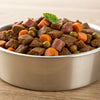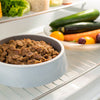Is It Okay for Dogs to Eat Only Wet Food? A Comprehensive Guide
- Houndsy
Table of Contents
- Introduction
- The Nutritional Landscape: Wet vs. Dry Dog Food
- Is It Okay for Dogs to Eat Only Wet Food?
- The Advantages of Mixing Wet and Dry Food
- How Houndsy Elevates the Feeding Experience
- Conclusion
Introduction
Imagine this: your dog wakes up each morning with the same insatiable enthusiasm, tail wagging and tongue out, ready for breakfast. However, as you scoop kibble into the bowl, your pup’s excitement dwindles. This scene might be all too familiar for many dog owners. The question is, would switching to wet food make a difference? Specifically, is it okay for dogs to eat only wet food?
With the abundance of dog food options available today, it can be challenging to determine the best diet for our furry friends. The decision between wet and dry dog food often leads to discussions filled with misconceptions and myths, leaving many of us wondering what truly suits our dogs. In this blog post, we aim to shed light on the merits and potential drawbacks of wet dog food and provide you with the information needed to make an informed decision about your dog's dietary needs.
By the end of this article, you will understand the nutritional implications of wet food, recognize which dogs might benefit from a wet-only diet, and learn about the pros and cons of feeding your pet exclusively wet food. We’ll also discuss how Houndsy can enhance your pet feeding experience, making this daily ritual enjoyable and visually appealing.
The Nutritional Landscape: Wet vs. Dry Dog Food
Understanding Wet Dog Food
Wet dog food typically contains higher moisture content—often up to 78%—when compared to dry kibble, which usually sits around 10% moisture. This high water content is a significant factor contributing to the appeal of canned dog food, especially for dogs who may need more hydration in their diet. The general process for creating wet food includes grinding meat ingredients, mixing in necessary vitamins and minerals, and then cooking and canning the mixture, preserving its nutrients and flavor.
Dry Dog Food: A Closer Look
Dry dog food, or kibble, is created through a process known as extrusion. The ingredients, similar to those in wet food, are cooked and transformed into dough, which is then cut into pieces and dried. The crunchy texture of kibble can help prevent dental issues by scraping plaque off your dog's teeth as they chew.
Nutritional Comparisons
- Hydration: Wet food provides hydration, making it an excellent option for dogs that do not drink enough water. Many medical conditions benefit from increased moisture, particularly for dogs with urinary or kidney issues.
- Caloric Density: Dry foods typically have a higher calorie content per cup than wet food, which can influence weight management strategies. This aspect may prove essential for dog owners managing weight in their pets.
- Palatability: Wet food is generally more flavorful and aromatic, potentially enticing picky eaters or recovering dogs with decreased appetites.
Benefits of Wet Dog Food
Let’s take a closer look at the specific benefits of incorporating wet food into your dog’s diet:
- Higher Moisture Content: Keeping your dog well-hydrated is crucial for overall health, particularly for specific breeds and dogs with certain health conditions.
- Enhanced Flavor Profile: Many dogs prefer the taste and aroma of wet food, making it an enticing option for those reluctant to eat.
- Ease of Chewing: For older dogs or those with dental problems, wet food can be easier to chew and digest, making mealtime more enjoyable for them.
- Satiety Factor: Wet food can create a feeling of fullness for longer, which may help in weight management strategies.
Potential Downsides of a Wet-Only Diet
While wet food has its benefits, it’s essential to consider the possible downsides of an exclusively wet diet:
- Dental Health Risks: Wet food does not provide the same dental benefits as dry kibble. The absence of the crunch may lead to tartar buildup, which can be managed through regular dental care routines.
- Storage Concerns: Opened cans of wet food require refrigeration and should be consumed within a few days, posing potential convenience issues for busy pet owners.
- Cost Factor: Wet food can be more expensive than dry kibble, especially for larger dogs that consume larger quantities.
- Variable Nutritional Quality: Not all wet dog foods are created equal. It's vital to choose high-quality brands free of fillers.
Is It Okay for Dogs to Eat Only Wet Food?
So, is it okay for dogs to eat only wet food? The straightforward answer is yes, as long as the wet food is nutritionally complete and balanced. Many dogs thrive on a diet of solely wet food, particularly those that are picky eaters, older dogs, or those needing additional moisture in their diet.
Special Considerations for Dogs on a Wet-Only Diet
-
Age and Health Status: Puppies and senior dogs may benefit the most from a wet diet due to their unique dental and dietary needs. Puppies' developing teeth might struggle with dry kibble, while older dogs may find wet food easier on their gums.
-
Dietary Balance: It’s crucial to ensure that the wet food you choose contains high-quality ingredients, comprehensive nutritional information, and is appropriate for your dog’s specific lifestyle and health needs.
-
Veterinary Guidance: Always consult with your veterinarian before making any significant changes to your dog’s diet. They can help determine the best nutritional options based on your dog’s age, breed, weight, and health condition.
The Advantages of Mixing Wet and Dry Food
Instead of only feeding wet food, we often recommend a mixed approach—combining both wet and dry food to capitalize on the benefits of each.
Advantages of Mixed Feeding
-
Balanced Nutrition: By mixing wet and dry food, you provide a comprehensive nutritional profile while capitalizing on the palatability of wet food.
-
Dental Health Maintenance: The crunchiness of dry kibble aids in dental hygiene, helping to keep tartar buildup at bay while still allowing your dog to enjoy the yummy flavors of wet food.
-
Variety in Mealtime: Dogs thrive on routine but also enjoy a little change. Alternate textures in their food can keep mealtime exciting!
Tips for Successful Transition
If you opt for a mixed feeding approach, transition gradually from dry to wet food. Start by mixing small amounts of wet food into dry kibble, gradually increasing the wet portion. This method will help your dog adjust both in taste and digestion.
How Houndsy Elevates the Feeding Experience
At Houndsy, we understand the importance of an enjoyable, healthy, and convenient feeding experience for both dogs and their parents. Our flagship product, the Houndsy Kibble Dispenser, is designed to enhance your dog feeding routine, offering a flawless blend of innovation and style.
Key Features of the Houndsy Kibble Dispenser
- Convenience and Ergonomics: The crank at a standing height eliminates the need for bending, making feeding hassle-free. It’s perfect for those of us with busy lives or physical limitations.
- Perfect Portion Control: With our dispenser, you can serve your dog the appropriate amount every time, ensuring they receive balanced nutrition without overeating.
- Aesthetic Design: Our mid-century modern design complements any home decor, proving that pet care can be beautiful!
- Safety First: The auto-locking mechanism prevents pet or toddler mishaps, adding an element of peace of mind while you’re busy.
With a large storage capacity of 25-30 lbs and a BPA-free liner to maintain freshness, the Houndsy Kibble Dispenser elevates the pet-feeding experience, making every mealtime not only functional but also delightful. Explore the Houndsy Kibble Dispenser here.
Conclusion
In considering whether it is okay for dogs to eat only wet food, the answer is largely dependent on the quality of the food and your dog’s individual needs. Wet food can offer numerous benefits, particularly in hydration and palatability, but maintaining a well-rounded diet incorporating both wet and dry options is often the most beneficial approach.
As responsible pet owners, we should prioritize our dog’s health and nutritional needs. By exploring nutrition and feeding routines, we can ensure our furry companions live happy, fulfilling lives!
FAQs
1. Can puppies eat only wet food?
Yes, puppies can thrive on a wet food diet as it is easier for their developing teeth to handle. However, ensure it’s nutritionally balanced and appropriate for their growing needs.
2. Can wet food cause dental issues?
Wet food can increase the risk of tartar buildup due to its lack of crunchy texture. Regular dental care, including brushing and dental treats, can counteract this.
3. Is wet food better for senior dogs?
Yes! Wet food can be beneficial for senior dogs as it’s easier to chew, contains more moisture, and can entice them to eat, maintaining their appetite.
4. Is there a risk of overfeeding with wet food?
As with any food, it’s important to measure portions. Always refer to feeding guidelines and adjust for any treats or snacks your dog may receive throughout the day.
5. How should I transition my dog to a wet food diet?
Gradually mix wet food into your dog’s current diet over several days to avoid digestive upset. Monitor their response and consult your veterinarian if you have any concerns.
To make your feeding experience as enjoyable as possible, consider incorporating the Houndsy Kibble Dispenser into your routine! Order yours today and elevate your dog feeding experience to a new level, ensuring both function and elegance in your home.













